Decision Support System
The Decision Support System (DSS) is a tool which shows how waste heat could be recovered in industrial processes. The minimum data required for the simulation can be taken from the CE-HEAT cadastre and more data can be further added by users to refine the results. The output is a pre-feasibility study useful also for policy makers to define which incentive schemes should be developed to make waste heat recovering an attractive investment.
What is the DSS?
The Decision Support System (DSS) has been developed within CE-HEAT project. The tool shows the opportunities of waste heat recovery in industrial processes.
By filling in the required data on waste heat and (possibly) on energy costs and incentive schemes, the Decision Support System identifies the available technologies from a technical and economic point of view. The considered technologies are:
- Organic Rankine Cycle (ORC) to produce electricity
- Absorption regeneration unit (ABS) for cooling
- Heat Exchanger (HE) for heating (ex. Pre-heating in a productive process)
- District Heating (District) for district heating (length of the grid is required)
- Heat Pump (HP) to rise the temperature of a source at a higher temperature
- Match solution (MATCH) with the installation of both an ORC and a District Heating
For each solution the DSS provides two energy environmental parameters - avoided CO2 emissions (CO2) and Primary Energy Saving (PES) - and four financial parameters - Payback Period (PB), Internal Rate of Return (IRR), Net Present Value (NPV) and Debt Service Coverage Ratio (DSCR).
 Figure 1 DSS output
Figure 1 DSS output
The solutions provided for each case are technologically viable, on the basis of the temperature of the waste heat and the emission profile, and economically feasible as they guarantee a PB<20 years, IRR>3.5% and DSCR>1.
The minimum dataset required in input is:
- Type of emission, the user can choose between fumes or water,
- Emission profile, the user can choose between continuous or discontinuous,
- The temperature, in Celsius degrees,
- The thermal power, in kW.
The advanced input requires:
- Thermal energy cost, the user can choose between 0,025; 0,05; 0,075; 0,1; 0,125; 0,15; 0,175; 0,2;
- Electricity cost, the user can choose between 0,03; 0,04; 0,05; 0,06; 0,07; 0,08; 0,09; 0,1; 0,11; 0,12;
- Grant: part of the initial investment covered by a sum of money provided by local/regional/national authorities, the user can choose between 0, 10, 20, 30, 40, 50%
- Incentive for saved TOE, the user can choose between 0, 100, 200, 300, 400€/TOE saved
- District heating length, in metres
The DSS has been designed to work jointly with the waste heat cadastre which is available on the on-line platform. The latter provides the user with all information needed for the DSS calculation.
Who uses the DSS and how?
The Decision Support System is designed mainly for investors and policy makers.
A potential investor can first check the waste heat cadastre for interesting waste heat sources. It is true that sources with high power, high temperature and continuous emission profile guarantee higher recovery opportunity, but sources physically located nearby energy demand could be preferred as the reuse of energy is easier. After choosing the source, the investorcan access data concerning the waste heat available in the cadastre. It is also possible to measure distances between the source and a potential energy demand. These data should be then used in the Decision Support System to assess different opportunities under an economic and technical point of view, as described in the previous paragraph.
Policy makers can make use of the DSS jointly with the waste heat cadastre to find waste heat sources available in their territories and assess the energy wasted in that area. Policy makers need to embed energy recovery planning in policy strategies to meet environmental goals. Recoverable waste heat sources, should be selected within the waste heat cadastre and data used in the DSS. Policy makers, by setting different grants and incentives for saved TOE, can define which incentive schemes should be developed to make waste heat recovery bankable.
 Figure 2 Waste Heat Cadastre - waste heat information
Figure 2 Waste Heat Cadastre - waste heat information


